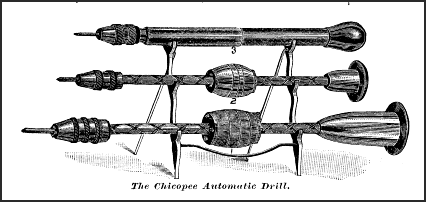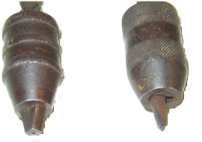

Updated 08/06/02
One drill that you may run across from time to time is the Chicopee Automatic Drill. These Archimedean drills were available in three styles, #1, #2 and #3. The above drawing shows the drills as pictured in an 1883 edition of The Manufacturer and Builder (From the Cornell University Web site--The Making of America) Thanks to Darrell LaRue of Ontario for pointing me to this reference. The accompanying text can be seen here.
Chicopee #1 Drill
The #1 drill was 14 1/2 inch long. It had a hardwood slide and all else was iron. It's chuck held any size of Morse twist drills up to 3/16 inch diameter. The top screwed off to provide storage for bits. The #2 was the same as the # 1 with the exception of the length (12") and the tool is all metal including the slide. The #3 has an all metal tubular construction and unlike the #1 and #2 could be used one handed which was a clear advantage at least in light drilling tasks.
***** Note: The highlighted patent numbers in the following paragraphs hyperlink to a page which allows you to view the patent images by clicking on the IMAGES box. You must have a viewer capable of reading TIFF format. The QuickTime plug in is supposed to be capable of this but I have had better luck with Alternatiff a free viewer for Windows which is a small download and installs easily. http://www.alternatiff.com/ ******
On April 19, 1881 George D. Belcher of Springfield Massachusetts was awarded patent #240,223 for a "Hand-drill". Belcher assigned one half of this patent to William C. McClallan "of the same place". George indicated in the patent papers that this was an improvement of George D. Washburn's patent #24,894 from July 26th, 1859. The patent design was "a stem having one end revolving in a handle and its other end provided with a drill (and) has intersecting right and left grooves and a nut sleeve, which, when reciprocated on said stem, imparts a rotary motion in one and the same direction to the drill" So Washburn's ,and consequently Belcher's, design was for an Archimedean style drill in which the bit spun in a clockwise direction whether the operating force was pushing down or retracting up. Common Archimedean drills reverse direction as the stroke alternates. Washburn mentions in his patent description that others had achieved the same result as his patent using "flywheel and ratchets" He names "McDowell's Archimedean boring tool" as an example. Obviously their was more efficiency in the Washburn design. Belcher's patent was a refinement of Washburn's having "for their object the perfection of the mechanism for producing the results aimed at by reducing to the minimum the friction between the operating-nut and screw-stem"
George D. Belcher was listed in the 1860 US Census living in Chicopee, Mass. He apparently served in the Union Army, 61 Massachusetts infantry enlisting as a private and being discharged at the rank of corporal. He is listed in the 1890 and 1891 Springfield Massachusetts city directory as a machinist living at 37 Center Chicopee, Mass. I have found two other patents issued to Belcher. One is patent #131,326 (Sept 17, 1872) for a hand vise and #150,672 (May 12, 1874) for a drill chuck. I suspect that there are more but I do not have a way to search for patents by inventors name. Belcher's patent covered only the #1 and #2 drills.
The three examples of the Chicopee drills that I have are marked: PAT APRIL 19, 81 CHICOPEE, MASS on the upper part of the head portion. The chucks are marked PAT AUG 15 '82 CHICOPEE, MASS. This is patent #262,771 by John H. Hoague of Chicopee. Hoague also held patent #281,068 (July 10, 1883) which was for the all metal #3 Chicopee drill .
John was the proprietor of J.H. Hoague and Co., the manufacturer of these drills. John is listed in the working draft of of the Directory of American Tool Makers alone and in partnership with a "Peck" in the manufacture of a chamfer gage. Hoague's patent #366,724 (July 19, 1887) covers this vernier style adjustment chamfer gage with a marked scale.
In addition to Belcher and Hoague being involved in the inventing and manufacturing of this drill another patent was also issued. D.Fletcher Barber of Newton Massachusetts was granted Patent #284,799 for a "hand drill" on September 11, 1883.
If I understand the patent description correctly Barber's invention imparts an ability to the Belcher and Hoague design to be used as an Archimedean drill or as a bow drill. He says in the patent specification: "When the invention is applied to the drill known as the "Chicopee drill" patented to J.H. Hoague August 15, 1882 No. 262,771 the handle may be rigidly affixed to A by a set screw..." So his invention was a variation of the other two inventions. I have not seen an example of this drill so it may not have ever been manufactured.
Jack Kamishlian contributed to the Old Tools list that he had
acquired a drill of the Chicopee type marked :PAT'D AUG 15, 1882 MFD BY
O.W. BULLOCK & CO. SPRINGFIELD, MASS. That is still Hoague's chuck
patent although Jack did state that the chuck on his appeared different than the
two styles I picture on this page. An "automatic drill" marked the same as above
was offered in the 1993 summer auction catalog for the Fine Tool Journal. The
chuck on that was definitely different than those normally seen. O.W.
Bullock & Co, 41 Cross St, Springfield was a manufacturer of watchmakers
tools. Sawsets and wrenches have also been found marked "Bullock". They were
listed in the 1888 through 1891 Springfield directories. The same directories
list 19 people as employees of the company. Orvus Bullock held two patents for
watchmakers tools, Patent 251,183 and Patent 251,182 ( both issued Dec 20, 1881)
Bullock may have held more patents but these are all I have found at this time.
The DATM indicates that O.W. Bullock was in business from 1882 to
1905.I have purchased a ratcheting screwdriver from Martin J. Donnelly's Live Free Or Die auction.
It is marked "Bullock Manufacturing Associates,
Springfield, Massachusetts. Patented June 8, 1909" It seems that Bullock
was still in business under a new name.
 The tool was patent #924372
issued to W.A. Peck of Jersey City, N.J. (Remember that Peck guy associated with
John Hoague?) Peck was a prolific inventor with at least four more boring tool
patents issued to him: No's 814318, 814319 and 814320 (for various parts of a
brace) issued on March 6, 1906, No. 954,046 (for an extension bit holder)
issued on April 5, 1910 and No. 1,033,615 issued on July 23rd, 1912.
The tool was patent #924372
issued to W.A. Peck of Jersey City, N.J. (Remember that Peck guy associated with
John Hoague?) Peck was a prolific inventor with at least four more boring tool
patents issued to him: No's 814318, 814319 and 814320 (for various parts of a
brace) issued on March 6, 1906, No. 954,046 (for an extension bit holder)
issued on April 5, 1910 and No. 1,033,615 issued on July 23rd, 1912.
The connection between Bullock, Hoague and Belcher (and Peck?) is unclear. What is not unclear is that during this period of time Springfield, Massachusetts was a major center of manufacturing based upon the American Standardized method which was developed at the Springfield Armory earlier in the century. There were thousands of machinists employed in this area. It has been related to me that Hoague and Belcher had both been employed at Ames Manufacturing in Springfield. It is possible that Bullock, besides manufacturing the watchmakers tools that he was known for, also made tools under contract for inventors that did not want to equip an entire plant to produce one or two innovative tools.
The 1888 catalog of William P Walters Sons shows the
Chicopee drills. One feature mentioned is the fact
that the slide could be engaged with the top of the chuck to allow for better
leverage in changing bits. The chucks were also sold separately with an internal
thread, a square shank or in a boxed set with tools. The 2 jaw chuck is
effective at holding smaller round bits. The chucks have been seen in two
versions:
slide could be engaged with the top of the chuck to allow for better
leverage in changing bits. The chucks were also sold separately with an internal
thread, a square shank or in a boxed set with tools. The 2 jaw chuck is
effective at holding smaller round bits. The chucks have been seen in two
versions:
The 1896 Hammacher, Schlemmer & Co catalog illustrates the #1 and #2 drill. I had not found these drills offered after this until Jim Erdman of Menomonie, Wisconsin shared a catalog cut with me from a 1907 Montgomery Tool Catalog in his possession. The Chicopee drill (#1 and #2, of the George Belcher style) is offered in that catalog. So the drills were offered in one form or another for over 22 years. Their demise was probably because of the stiff competition from North Brothers, Goodell-Pratt's and Millers Falls. The Chicopee drills never had the distribution and promotion that the more prominent brands did.
I will wrap this Chicopee drill page up today (February 21, 2002) but I am sure that I will be adding even more information in the future. One thing that I discovered in assembling this page is that each new bit of data leapfrogs to another. Every time that I thought that I had put this to bed I found another patent, another tool or another reference to add. Maybe your contribution will be the next break. I appreciate all input.
Copyright February 21, 2002 Charles R. Zitur for original text and jpegs.
References
Information from Manufacturer and Builder Magazine Volume 15, Issue 10 page 221, October of 1883 from the Cornell University Making of America website. Permission has been sought for this.
http://cdl.library.cornell.edu/cgi-bin/moa/moa-cgi?notisid=ABS1821-0015-629
Patent images and text are from the US Patent office website. http://www.uspto.gov
Scan of 1888 catalog of William P Walters Sons was from a reprint published by Roger K. Smith Athol Mass. Mr. Smith gave his permission and provided a "clean" page to scan.
Thanks to Jack Kamishlian, Darrell La Rue and Jim Erdman for additional information.